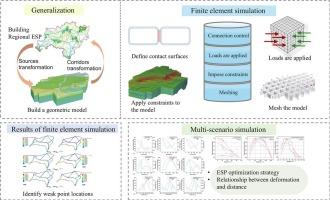有限元模拟:生态安全格局风险评估与格局优化的新方法
IF 11.2
1区 社会学
Q1 ENVIRONMENTAL STUDIES
引用次数: 0
摘要
生态安全格局的风险评估对于维持生态系统的连通性和稳定性至关重要。尽管已经开展了大量关于ESP构建的研究,但ESP风险分析仍然需要新的视角和方法。利用形态空间格局分析(MSPA)和回路理论构建区域ESP,为后续风险评估和优化奠定基础。本研究引入了一种创新的有限元模拟框架来识别生态廊道并评估其结构稳定性,为ESP优化提供了一种新的方法,解决了四个关键研究目标:(1)构建新的ESP分析方法;(2)模拟生态廊道,评价其在环境干扰下的稳定性;(3)建立多场景对比分析;(4)探索铺路石对廊道稳定性的影响。基于ESP构建的技术框架包括廊道离散化、面向有限元的廊道强度转换、廊道外部冲击荷载转换、生态源与垫脚石约束配置五个核心部分。该框架通过多场景分析,通过有限元模拟进一步优化ESP。通过结构分析,确定了具有潜在失稳(如高应力集中和高变形)的廊道,其中廊道B的变形最大(0.734 m),应力集中显著(200 MPa),表明易受环境干扰。多场景模拟表明,铺路石可以增强走廊的弹性,但铺路石的放置可能会破坏相邻走廊的稳定,因此需要进行战略性的空间规划。通过跨学科的方法,验证了在ESP风险评估和优化中实施有限元模拟的可行性,为生态保护研究提供了一个新的视角。本文章由计算机程序翻译,如有差异,请以英文原文为准。

Finite-element simulation: A new method for risk assessment and pattern optimization towards ecological security pattern
Risk assessments of ecological security patterns (ESPs) are crucial for maintaining ecosystem connectivity and stability. Although numerous studies of the construction of ESPs have been conducted, novel perspectives and approaches are still needed for ESP risk analysis. The regional ESP is constructed using morphological spatial pattern analysis (MSPA) and circuit theory, forming the basis for subsequent risk assessment and optimization. This study introduces an innovative finite-element simulation framework to identify ecological corridors and assess their structural stability, providing a new approach for ESP optimization, addressing four key research objectives: (1) constructing a novel ESP analysis method, (2) simulating ecological corridors to evaluate their stability under environmental disturbances, (3) establishing multi-scenario comparative analyses, and (4) exploring the impact of stepping stones on corridor stability. The technical framework constructed on the basis of the ESP comprises five core components: corridor discretization, finite element-oriented corridor strength conversion, load transformation from external impacts on corridors, and constraint configurations for ecological sources and stepping stones. The framework is used to further optimize the ESP through finite-element simulations via multiple scenario analyses. Corridors with potential instability (e.g., high stress concentration and deformation) are identified through structural analysis, with corridor B exhibiting the maximum deformation (0.734 m) and significant stress concentration (200 MPa), indicating vulnerability to environmental disturbances. Multi-scenario simulations reveal that stepping stones enhance corridor resilience, but their placement may destabilize adjacent corridors, necessitating strategic spatial planning. Through an interdisciplinary methodology, the feasibility of implementing finite-element simulations in ESP risk assessment and optimization is verified, offering a novel perspective for ecological conservation research.
求助全文
通过发布文献求助,成功后即可免费获取论文全文。
去求助
来源期刊

Environmental Impact Assessment Review
ENVIRONMENTAL STUDIES-
CiteScore
12.60
自引率
10.10%
发文量
200
审稿时长
33 days
期刊介绍:
Environmental Impact Assessment Review is an interdisciplinary journal that serves a global audience of practitioners, policymakers, and academics involved in assessing the environmental impact of policies, projects, processes, and products. The journal focuses on innovative theory and practice in environmental impact assessment (EIA). Papers are expected to present innovative ideas, be topical, and coherent. The journal emphasizes concepts, methods, techniques, approaches, and systems related to EIA theory and practice.
 求助内容:
求助内容: 应助结果提醒方式:
应助结果提醒方式:


